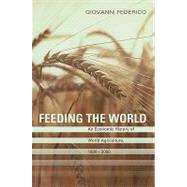
Note: Supplemental materials are not guaranteed with Rental or Used book purchases.
Purchase Benefits
Looking to rent a book? Rent Feeding The World [ISBN: 9780691138534] for the semester, quarter, and short term or search our site for other textbooks by Federico, Giovanni. Renting a textbook can save you up to 90% from the cost of buying.
| List of Illustrations | p. ix |
| List of Tables | p. ix |
| Preface | p. xiii |
| Introduction | p. 1 |
| Why Is Agriculture Different? | p. 5 |
| Introduction | p. 5 |
| Agriculture and the Environment: An Uneasy Relationship | p. 5 |
| Factor Endowment and the Characteristics of Agriculture | p. 13 |
| Trends in the Long Run | p. 16 |
| Introduction | p. 16 |
| Output | p. 16 |
| Prices | p. 21 |
| The Composition of Agricultural Output | p. 26 |
| Trade | p. 28 |
| Patterns of Growth: The Inputs | p. 31 |
| Introduction | p. 31 |
| Land | p. 31 |
| Capital | p. 40 |
| Labor | p. 56 |
| Conclusion: Factor Endowment and Factor Prices in the Long Run | p. 64 |
| The Causes of Growth: The Increase in Productivity | p. 69 |
| Introduction | p. 69 |
| The Productivity of Land and Labor | p. 70 |
| The Total Factor Productivity | p. 74 |
| Conclusion: On the Interpretation of Total Factor Productivity Growth | p. 82 |
| Technical Progress in Agriculture | p. 83 |
| Introduction: Productivity Growth and Technical Progress | p. 83 |
| The Major Innovations | p. 84 |
| The Macroeconomics of Innovations: Factor Prices and Technical Progress | p. 93 |
| The Microeconomics of Agricultural Innovation: Appropriability, Complementarity, Environment, and Risk | p. 101 |
| The Microeconomics of Agricultural Innovation: Research Institutions and Technical Progress | p. 105 |
| Conclusion: On the Causes of Technical Progress | p. 114 |
| The Microeconomics of Agricultural Institutions | p. 117 |
| Introduction: What Are the Institutions, and Why Should We Care about Them? | p. 117 |
| Property Rights | p. 118 |
| The "Structure": Matching Land and Labor | p. 121 |
| Finding the Money: Formal and Informal Credit | p. 128 |
| The Co-operative: The Best of All Possible Worlds? | p. 133 |
| Conclusion: Is There an "Ideal" Farm? | p. 136 |
| Agricultural Institutions and Growth | p. 143 |
| Introduction | p. 143 |
| Prelude: The Establishing of Modern Property Rights | p. 144 |
| Meddling with Property Rights: Land Reform and Other Structural Interventions | p. 149 |
| The "Structural" Change in the Long Run | p. 152 |
| The Development of Markets | p. 160 |
| Self-help: The Growth of the Co-operative Movement | p. 168 |
| Institutions and Agricultural Growth: The Creation of Property Rights and "Structural" Interventions | p. 172 |
| Institutions and Agricultural Growth: Landownership, Farm Size, and Contracts | p. 177 |
| Institutions and Agricultural Growth: The Development of Markets | p. 181 |
| Conclusion: Did Institutions Really Matter? | p. 186 |
| The State and the Market | p. 187 |
| Introduction: On the Design of Agricultural Policies | p. 187 |
| Before 1914: The Era of Laissez Faire | p. 189 |
| The Interwar Years: The Great Discontinuity | p. 191 |
| The OECD Countries after 1945: The Era of Surpluses | p. 196 |
| The Less Developed Countries after Independence: The Green Revolution and the "Development" Policies | p. 201 |
| The Socialist Countries | p. 205 |
| On the Effects of Agricultural Policies | p. 211 |
| Conclusion: The Political Economy of Agricultural Policies | p. 215 |
| Conclusions: Agriculture and Economic Growth in the Long Run | p. 221 |
| Fifteen Stylized Facts | p. 221 |
| Agriculture and Economic Growth: Some Theory | p. 222 |
| Agriculture and Economic Growth: Debates and Historical Evidence | p. 226 |
| Concluding Remarks: A Look to the Future | p. 231 |
| Statistical Appendix | p. 233 |
| Notes | p. 251 |
| Bibliography | p. 325 |
| Index | p. 381 |
| Table of Contents provided by Ingram. All Rights Reserved. |
The New copy of this book will include any supplemental materials advertised. Please check the title of the book to determine if it should include any access cards, study guides, lab manuals, CDs, etc.
The Used, Rental and eBook copies of this book are not guaranteed to include any supplemental materials. Typically, only the book itself is included. This is true even if the title states it includes any access cards, study guides, lab manuals, CDs, etc.